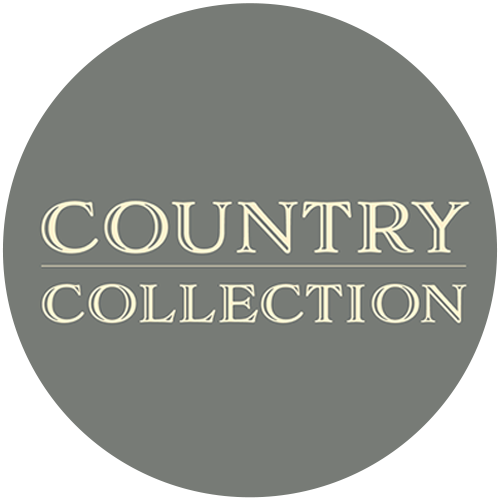Comprehensive Guide on Wool and Yarn: All You Need to Know
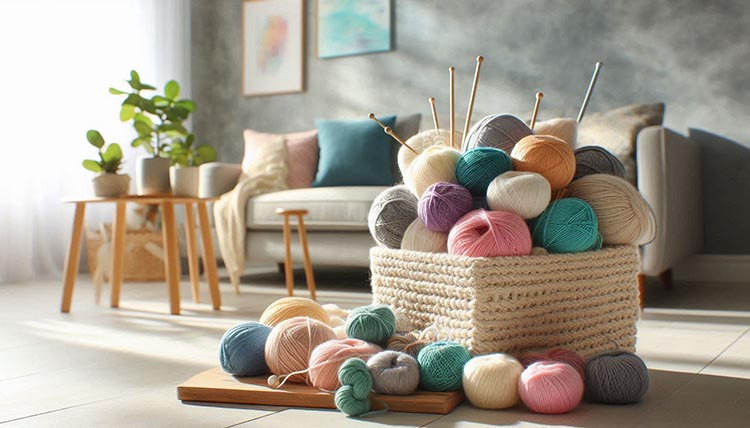
Welcome, seasoned crafters! Whether you’re a knitting aficionado, a crochet enthusiast, or a sewing devotee, understanding yarn is essential for creating timeless pieces. This guide delves into the different types of yarn, their weights, and how to select the perfect one for your projects. Let’s explore the wonderful world of yarn together!
Summary
Definition of Yarn
What is yarn? Yarn is a continuous strand of fibres twisted or spun together and used in knitting, crocheting, weaving, and other textile crafts. It can be made from natural materials like cotton, silk, or wool and synthetic fibres such as acrylic or nylon. Yarn comes in different weights, textures, and colours, making it versatile for all sorts of creative projects.
Definition of Wool
Wool is a natural fibre obtained from the fleece of sheep and other animals like goats (cashmere) and alpacas. Known for its warmth, durability, and elasticity, wool is commonly used in making garments such as sweaters, scarves, and blankets. It’s prized for its ability to retain heat and wick moisture, making it a favourite for cosy clothing and accessories.
What's the Difference Between Wool and Yarn?
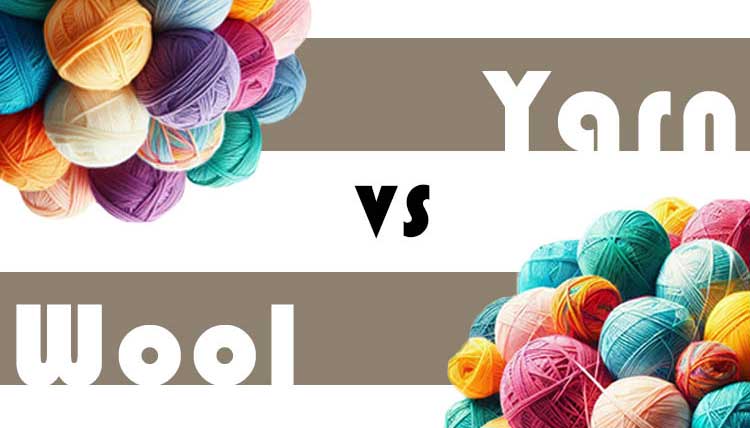
Although often used interchangeably by beginners, wool and yarn are not quite the same thing. Understanding the difference is essential for any crafter who wants to make informed decisions about materials.
Wool
Wool specifically refers to the natural fibre obtained from the fleece of animals, most commonly sheep. Wool can also come from other animals like goats (cashmere and mohair), alpacas, and rabbits (angora).
Wool fibres are known for their warmth, elasticity, and moisture-wicking properties, making them an excellent choice for creating garments meant to keep you warm in colder weather.
Wool can come in various forms, from raw fleece straight off the animal to refined yarn ready for knitting or crocheting. It's renowned for its softness (especially in finer wools like Merino), durability, and ability to regulate body temperature. However, wool is just one type of fibre used to create yarn.
Yarn
On the other hand, yarn is the finished product made by spinning raw fibres together to create a continuous strand that can be knitted, crocheted, woven, or used in other crafts.
Yarn can be made from many different types of fibres, both natural and synthetic. While wool is a popular choice, yarn can also be made from cotton, silk, bamboo, acrylic, polyester, and blends of different fibres.
Yarn comes in various weights (thicknesses) and textures, depending on how the fibres are spun and the material used. It's available in countless colours, textures, and fibre blends, offering endless possibilities for your projects.
Yarn Materials
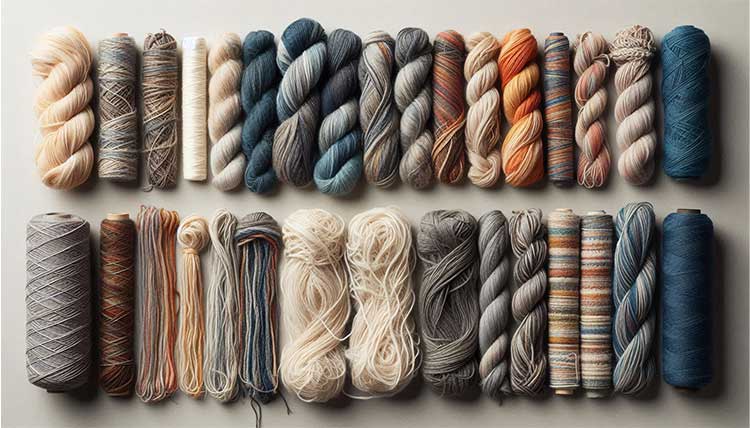
Yarn materials significantly impact the feel, durability, and appearance of your projects. Understanding these materials will help you make informed choices for your creations. For a deeper understanding of various yarn types and their special qualities, don’t miss our Ultimate Guide on 19 Types of Yarn to find the best fit for your next project.
Natural Yarn Types
Animal Fibres:
Wool
Wool yarn is known for its elasticity and warmth, making it ideal for projects that need to retain shape and warmth, such as sweaters and blankets. Different types of wool, like merino, Shetland, or Icelandic, offer various textures and qualities. Merino wool is especially soft and great for next-to-skin wear.
Mohair
Derived from the Angora goat, mohair yarn is distinguished by its fluffy, halo-like texture. It’s often used in combination with other yarns to add a soft, airy quality to garments. Mohair is excellent for creating lightweight, luxurious items like shawls and cardigans.
Cashmere
Cashmere yarn is incredibly soft and lightweight, providing exceptional warmth without bulk. Ideal for high-end garments and accessories, cashmere yarn can be quite expensive but is worth the investment for its supreme comfort and drape.
Angora
Angora yarn, made from the fur of Angora rabbits, is incredibly soft and has a distinct fluffy texture. While it’s excellent for delicate items like baby clothes, it requires careful handling and care to maintain its softness.
Alpaca
Alpaca yarn is renowned for its silky texture and warmth. It’s less itchy than wool and is a great choice for sensitive skin. Alpaca comes in various grades, with baby alpaca being the softest and most luxurious.
Silk
Silk yarn has a natural sheen and drapes beautifully, making it ideal for elegant garments like evening wear or shawls. It’s also strong and durable, though it can be slippery to work with.
Plant Fibres:
Plant-based yarns offer unique textures and are often more breathable, making them ideal for certain projects:
Cotton
Cotton yarn is soft, breathable, and highly absorbent, making it perfect for summer garments, dishcloths, and baby items. It doesn’t have the elasticity of wool, so projects may need more shaping adjustments.
Bamboo
Bamboo yarn is known for its silky feel and antibacterial properties. It’s a great option for lightweight garments and accessories, offering a natural sheen and smooth texture.
Tencel
Made from wood pulp, Tencel yarn is soft, smooth, and environmentally friendly. It has excellent drape and moisture-wicking properties, making it ideal for comfortable, stylish garments.
Linen
Linen yarn is strong and becomes softer with each wash, making it a durable choice for summer wear. It’s cool and breathable, though it can be a bit stiff until it’s broken in.
Other Natural Fibres:
Hemp
Hemp yarn is highly durable and becomes softer with use. It’s excellent for making sturdy items like bags, belts, and home decor. Hemp yarn has a natural, rustic appearance.
Soy
Soy yarn, made from soybeans, is a newer addition to the yarn world. It’s soft, and smooth, and offers a luxurious feel similar to silk, making it a good option for lightweight, breathable garments.
Synthetic Yarn Types:
Synthetic yarns are valued for their affordability, durability, and wide range of textures and colours:
Acrylic
Acrylic yarn is versatile and budget-friendly, making it ideal for a wide range of projects. It’s easy to care for, holds colour well, and is often used for everyday garments and blankets.
Nylon
Nylon yarn is known for its strength and elasticity, making it a great choice for socks and items that need to withstand wear and tear. It also helps yarn retain its shape and can add a slight sheen.
Polyester
Polyester yarn is durable, resistant to wrinkles and shrinking, and easy to wash. It’s often used in a blend with other fibres to add strength and resilience to garments.
Rayon
Rayon yarn is smooth and drapey, providing a soft, luxurious feel. It’s ideal for lightweight, elegant garments and has a nice sheen that adds a touch of sophistication.
Spandex
Spandex adds stretch to yarn, making it suitable for projects that require flexibility, such as activewear and stretchy accessories.
Modacrylic
Often used in novelty yarns, modacrylic is versatile and can mimic the look of natural fibres. It’s durable and resistant to flame, making it useful for certain applications.
Olefie
Olefin yarn is lightweight and moisture-resistant, making it ideal for outdoor gear and items that need to resist water.
Polypropylene
This yarn is strong and durable, often used in industrial applications. It’s resistant to stains and chemicals.
Viscose
Viscose yarn is smooth and soft, with a good drape. It’s often used in blends to add a silky texture and enhance the feel of the yarn.
Lurex
Lurex yarn is a speciality yarn with metallic threads that add sparkle to your projects, making it perfect for festive or glamorous pieces.
Yarn Weights Explained
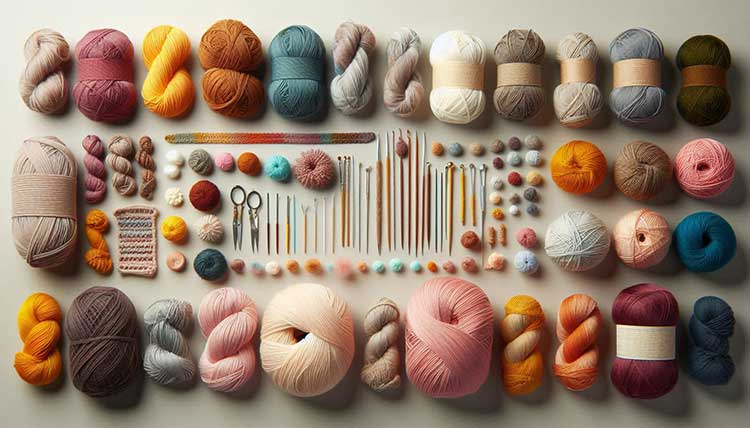
Yarn weight affects the texture, drape, and overall look of your finished project. Understanding yarn weights will help you choose the right yarn for your patterns. For a more detailed explanation of yarn weights, read our blog Yarn Weight and Gauge Chart with Helpful Explanations.
Lace Weight
Lace weight yarn is the thinnest and lightest, making it ideal for delicate and intricate patterns like lace shawls, doilies, and fine-knit garments. Due to its thinness, it often requires more patience and precision.
Fingering or Super Fine Weight
This weight is slightly thicker than lace and is often used for lightweight, close-fitting items such as socks, baby garments, and intricate shawls. It offers a balance between delicacy and durability.
Sport Weight
Sport weight yarn is a medium weight that’s versatile for various projects. It’s suitable for lightweight sweaters, baby blankets, and scarves. It provides a good balance between thickness and manageability.
DK (Double Knitting)
DK weight yarn is a popular choice for everyday projects due to its easy use and good coverage. It’s suitable for a variety of garments, including sweaters, hats, and shawls. It’s often used in patterns that call for a moderate thickness.
Worsted Weight
Worsted weight yarn is one of the most common and versatile weights. It’s ideal for a wide range of projects, from cosy sweaters and scarves to blankets and accessories. It provides good stitch definition and warmth.
If you'd like to know more about this weight of yarn, we have the perfect guide. What is Worsted Weight Yarn? Everything You Need to Know. Discover what it is, how to use it, what needles you'll need and much more.
Aran or Afghan Weight
Aran weight yarn is slightly thicker than worsted and is used for warmer, heavier projects. It’s great for making thick blankets, warm sweaters, and heavy scarves.
Bulky or Chunky Weight
Bulky yarn is thick and works up quickly, making it ideal for projects that need to be finished fast, like blankets, hats, and cowls. It provides a lot of warmth and a textured look.
Super Bulky or Super Chunky Weight
The thickest yarn available, super bulky yarn is used for extra-large projects such as rugs, chunky blankets, and oversized sweaters. It creates a bold, dramatic effect and works up quickly.
Jumbo Weight
Jumbo yarn is the ultimate for the largest projects. It’s used for extremely chunky items like large blankets or giant pillows, and it creates a striking visual impact.
Uses of Wool and Yarn
Yarn is an incredibly versatile material, and its applications extend far beyond basic garments and accessories. Here’s an expanded look at the many ways you can use different yarn types.
If you would like to be truly amazed at how far the uses of wool can be stretched, read 10 Common, 10 Surprising & 10 Bizarre Uses of Wool and be astonished at what wool can accomplish.
Knitting

Knitting yarns are primarily used to create garments such as sweaters, cardigans, and dresses. The choice of yarn weight and fibre content will impact the garment's drape, warmth, and texture. For instance, soft merino wool is great for cosy sweaters, while cotton yarn is ideal for lightweight summer tops.
Accessories
Hats, scarves, gloves, and shawls are popular knitted accessories. Novelty yarns like bouclé and eyelashes can add a unique touch to these items, creating textured or feathery effects that enhance their appeal.
Home Decor
Knitted home decor items like blankets, cushions, and throws benefit from yarns that provide warmth and texture. Chunky or super bulky yarns are excellent for creating quick, cosy blankets, while cotton or linen yarns are perfect for summer throws and kitchen accessories.
Baby Items
Soft and gentle yarns such as cotton, bamboo, or baby alpaca are ideal for creating baby garments and blankets. These yarns are gentle on sensitive skin and provide the warmth and softness needed for baby clothing and toys.
Crocheting
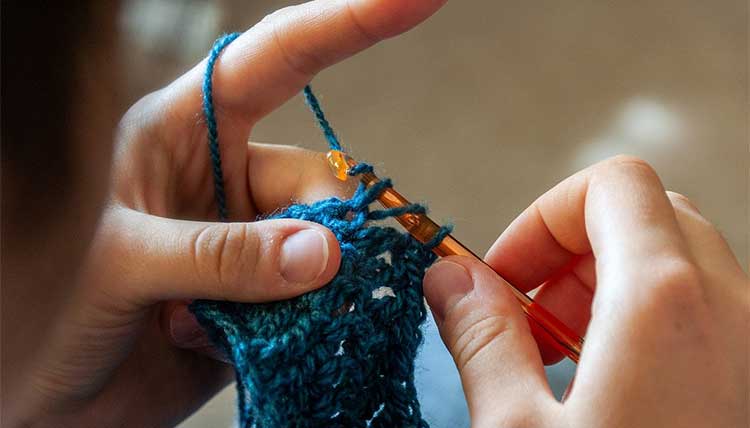
Garments
Similar to knitting, crochet is used to make a variety of garments including sweaters, vests, and skirts. The texture and drape of crochet projects can be enhanced with different yarn types. For example, silk yarns can create elegant and drapey garments, while acrylics offer durability and ease of care.
Accessories
Crocheted accessories like bags, hats, and shawls can be made with virtually any yarn type. Yarn with interesting textures, like chenille or feather yarn, can be used to make eye-catching accessories with a unique feel.
Home Decor
Crochet is fantastic for home decor projects like rugs, doilies, and table runners. Sturdy yarns such as cotton or linen work well for creating durable, washable items. Conversely, softer yarns can be used for decorative throws and cushions.
Amigurumi
This Japanese art of crocheting small, stuffed animals or dolls often uses fine, smooth yarns to achieve detailed and durable results. Acrylic and cotton yarns are commonly used for amigurumi projects due to their availability in a wide range of colours and their durability.
Weaving
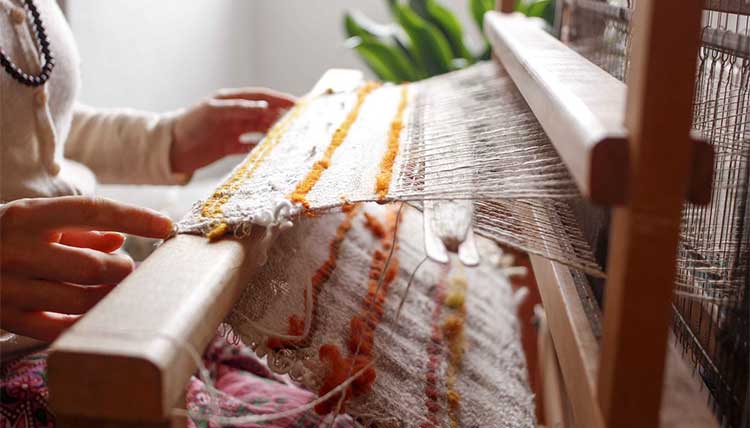
Textiles
Weaving allows for the creation of fabric for various uses, from clothing to home textiles. Different yarn types can be used based on the desired outcome. For instance, wool yarns are great for warm, heavy fabrics, while cotton yarns create breathable, lightweight textiles.
Rugs and Tapestries
Rug-making often involves sturdy yarns like wool or synthetic blends to create durable and functional floor coverings. Tapestries can benefit from textured yarns like bouclé or chenille to add depth and interest.
Embroidery
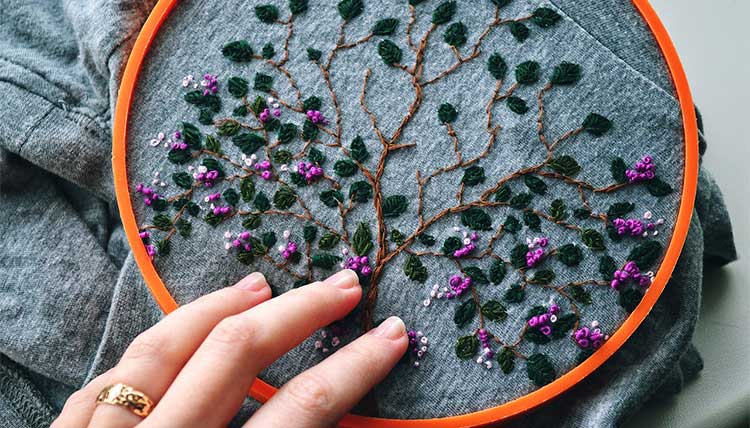
Decorative Stitching
Yarn can be used for embroidery to add texture and dimension to fabric. Variegated yarns or metallic threads can create beautiful, eye-catching designs on clothing, accessories, or home decor items.
Appliqué and Embellishment
Yarn can be used to embellish garments and accessories through appliqué techniques. Soft yarns like cashmere or alpaca can add luxurious, tactile details to finished pieces.
Craft Projects
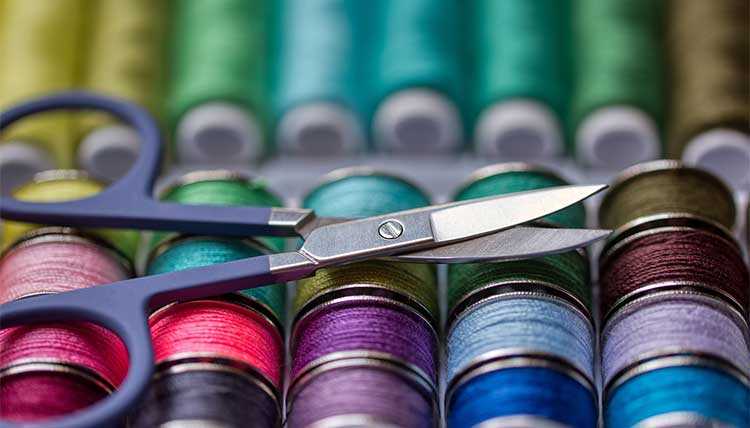
Scrapbooking and Cardmaking
Yarn can be used to embellish cards, scrapbook pages, and other paper crafts. Simple yarn accents can add texture and visual interest to handcrafted paper projects.
Gift Wrapping and Decorations
Yarn can be used creatively in gift wrapping and decorations. Using colourful or textured yarns as part of gift packaging or as decorative elements on handmade gifts adds a personal touch.
Specialty Projects
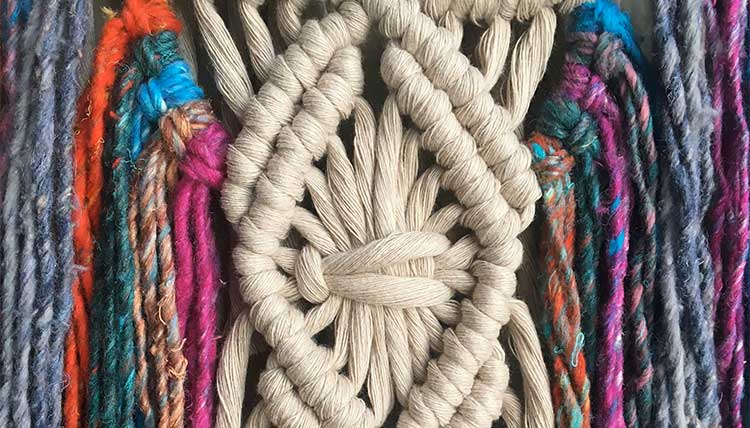
Fibre Art
Yarn is used in various fibre arts beyond knitting and crochet, including macramé and felting. These crafts use yarn in innovative ways to create intricate designs and functional art pieces.
Charitable Projects
Many crafters use yarn to create items for charity. This includes knitting or crocheting blankets for homeless shelters, hats for cancer patients, or toys for children in need. Charitable crafting can be a fulfilling way to use your skills and make a positive impact.
Seasonal and Holiday Crafts
Yarn is often used for seasonal decorations and holiday crafts. From Christmas ornaments and Easter baskets to Halloween costumes and Thanksgiving table runners, yarn adds a festive touch to various celebrations.
Choosing the Right Yarn
Selecting the perfect yarn for your project involves careful consideration. Here’s a step-by-step approach:
Understand Your Project Requirements
Review the pattern details to know the type, weight, and texture of yarn required. This helps in selecting a yarn that will match the pattern’s intended look and feel.
Match Substituted Yarn
If you need to substitute yarn, ensure it matches the original’s properties, including fibre content, weight, and texture. Consider doing a gauge swatch to check compatibility.
Make and Use a Gauge Swatch
A gauge swatch helps you determine if your chosen yarn will produce the correct size and fit. Make a small sample swatch with your yarn and compare it to the pattern’s gauge requirements.
Top Tips for Yarn Substitution
Attention to Detail Pay
Close attention to yarn properties such as fibre content, texture, and colour. Small differences can affect the outcome of your project.
Similar Yarns Aren’t Always Equal
Even if yarns seem similar, they can have different characteristics. Understanding these differences will help you achieve the desired result.
For a full detailed guide on how to find the perfect yarn substitute for your next project, read our easy-to-follow and helpful guide How to Find the Right Yarn Substitution and you’ll be crafting again in no time.
Additional Yarn Information
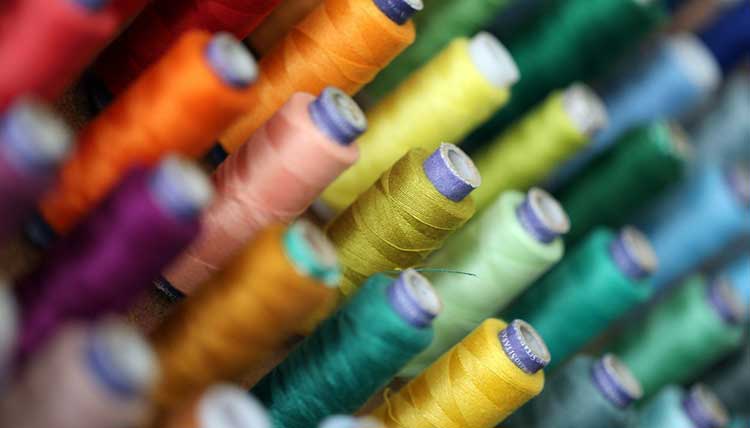
To fully understand yarn and its characteristics, consider these additional aspects:
Understanding Yarn Ply
Yarn ply refers to the number of strands twisted together. More plies generally make the yarn stronger and more durable. Single-ply yarns tend to be softer but can be less durable.
How Yarns Are Made
The process of creating yarn involves spinning fibres into threads and then twisting them into yarn. Knowing this process can help you understand yarn qualities and performance.
Dye Lots and Variations
Yarn dye lots can vary slightly, so for larger projects, it’s important to buy enough yarn from the same dye lot to ensure colour consistency.
Reading Yarn Labels
Yarn labels provide essential information, including fibre content, weight, and care instructions. Reading and interpreting these labels helps you choose the right yarn for your project.
Specialty Yarns
Add a unique touch to your projects with speciality yarns:
Variegated and Self-Striping Yarns
These yarns feature changing colours or patterns that can create beautiful, intricate designs without extra effort. Perfect for adding visual interest to your projects.
Novelty Yarns
Yarns like bouclé, chenille, and metallic offer unique textures and effects. Use them to create eye-catching accessories or add special details to your projects.
Fun Facts About Yarn
Yarn has been a part of human history for thousands of years, and some of the stories behind it are truly fascinating. Here are a few fun facts that highlight the long and colourful history of yarn:
The Oldest Yarn Ever Found:
Believe it or not, yarn goes back to the days of Neanderthals! Archaeologists discovered a piece of string made between 41,000 and 52,000 years ago in the Abri du Maras cave in southern France. This early "yarn" was made from the inner bark of a tree, likely a conifer, and twisted together from natural fibres. Even our ancient ancestors were resourceful crafters!
The Longest Crochet Chain:
In 2021, elementary school students in Berlin, Germany, along with their parents and teachers, worked together for nine months to create the world's longest crochet chain. It measured an astounding 345.7 km (214.80 miles), proving that teamwork and a love for yarn can accomplish amazing feats!
Yarn Bombing:
Yarn bombing is a delightful form of street art where knitters and crocheters cover everyday objects like trees, benches, and even lamp posts with colourful yarn creations. It's a whimsical way to brighten up urban environments and showcase the beauty of yarn in unexpected places.
Knitting for Health:
Did you know that knitting and crocheting can improve your health? These relaxing crafts are known to lower blood pressure and reduce stress. The repetitive motions of knitting and crocheting have a meditative effect, helping both body and mind. Crafting can be as soothing as it is creative!
Less Known Facts About Yarn Crafts
Even seasoned crafters might be surprised by these less-known facts about the yarn world:
Cassini’s "Ball of Yarn" Orbits:
NASA’s Cassini spacecraft orbited Saturn for 13 years, taking a path that looked like a giant tangled ball of yarn! Its nearly 300 looping orbits around the planet and its moons helped scientists uncover amazing discoveries about Saturn’s rings and its fascinating moons. Who knew yarn could inspire space exploration?
Knitters Have Their Own Code:
Advanced knitters often use their own form of shorthand when creating patterns. A pattern might read something like "K2, P1, YO," which translates to knit two stitches, purl one stitch, and yarn over. Decoding these secret messages can be half the fun!
Eco-Friendly Yarns:
Some yarns are made from recycled materials, like plastic bottles or reclaimed denim. Sustainable options are great for eco-conscious crafters looking to reduce their carbon footprint.
The "Second Sock Syndrome":
Crafters who knit socks often joke about "second sock syndrome"—the lack of motivation to make the second sock after completing the first one. It’s a common struggle among sock knitters!
Yarn for a Cause:
Yarn crafts have long been used for charitable purposes. From knitting scarves for the homeless to crocheting blankets for animal shelters, the yarn community often comes together to help those in need.
Weaving It All Together: The Final Stitch
Yarn and knitting are more than just a pastime; they’re an art form, a therapeutic hobby, and a gateway to endless creative possibilities. We’ve explored:
The wide variety of yarn types, including natural and synthetic fibres. The importance of yarn weights, from lace to super bulky, and how they impact your projects. How to choose the perfect yarn for your knitting or crochet based on texture, fibre, and weight. Novelty yarns, such as bouclé, eyelash, and metallic yarn, which offer unique textures and visual effects. Fun and lesser-known facts about the history and quirky uses of yarn.
Ready to Weave Your Next Yarn Tale?
Now that you’re armed with a wealth of yarn knowledge, it’s time to dive deeper into the world of knitting, crochet, and yarn crafts! Whether you're a seasoned crafter or just getting started, the possibilities are endless.
Experiment with new fibres, try out fun patterns, or even explore yarn bombing in your community! Don’t forget to keep challenging yourself with new techniques—you never know what amazing projects you might create next.
Happy crafting! ✂️🧶





































